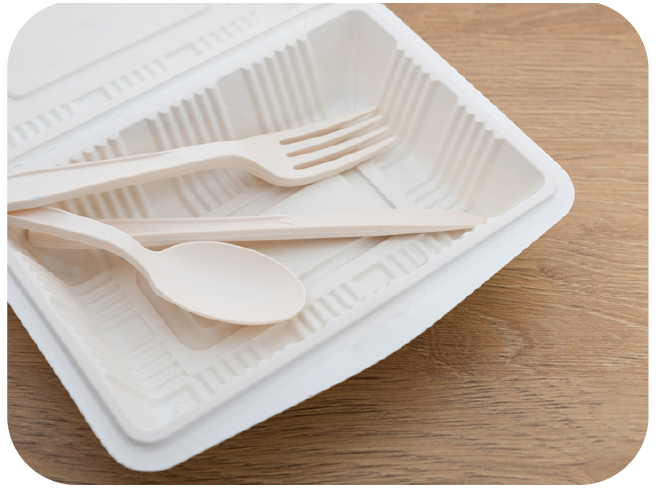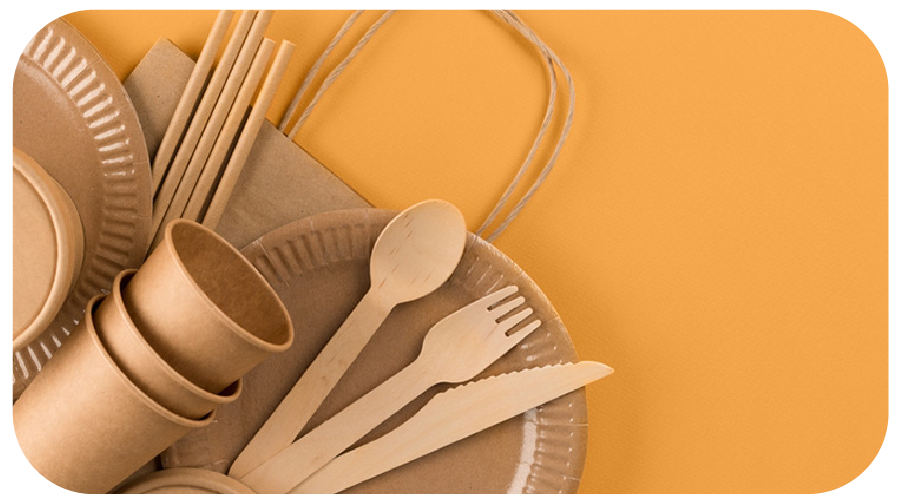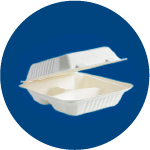

Currently, various raw materials are used for the manufacture of packaging (plastics, paper, cardboard, glass, metal, pulp, among others). Each offers different attributes with the purpose of preserving, transporting, and protecting the contained food.
In recent years, biodegradable packaging has gained great popularity in the market. This is because more consumers and users have become aware of the impact of packaging on the environment and are looking for other options.
Although ecological terms are very common, statistics and explanations are hard to find. Therefore, we present you with a compilation that will help you understand which biodegradable packaging is the most environmentally friendly compared to others, in such a way that it efficiently complements your business and personal objectives.
WHAT IS A BIODEGRADABLE PACKAGING?
¿QUÉ ES UN EMPAQUE BIODEGRADABLE?
We understand packaging as any product that facilitates the storage, distribution, presentation, use, and disposal of another product it contains. Usually, one of the most common raw materials in packaging are plastic resins.
Plastic resins come from hydrocarbons resulting from the oil extraction process and a chemical mix. Thanks to them, polymers often used by any industry, such as polyethylenes, polypropylenes, polystyrenes, PET and PVC resins (1), arise. Of course, these polymers offer enormous commercial benefits due to their variety of properties and their reduced economic value.

Now that we know the definition of packaging, we can define biodegradable packaging as those products that fulfill the objectives of conventional packaging (containing, protecting, transporting, and preserving), with the difference that they reintegrate into the ecosystem after disposal in less time due to the action of microorganisms present in the environment.
Biodegradable packaging can be made of different materials such as paper, cardboard, molded pulp, some biodegradable plastics (from oil) and some biodegradable bioplastics (from plants).

Being made of different materials, biodegradable packaging biodegrades in different environments, for example: at sea or on land. When it happens in open soil, where there is a lot of oxygen, it is called aerobic biodegradation, and when it is in an environment without the presence of oxygen, like in a biodigester, it is called anaerobic biodegradation.
Therefore, when they tell you that packaging is biodegradable, you should ask in what environment it biodegrades: industrial compost, home compost, in open soil, or at sea; this way, it can be properly disposed of for biodegradation to occur.
Al ser de diferentes materiales, los empaques se biodegradan en diferentes ambientes, por ejemplo: en el mar o en la tierra. Cuando sucede en suelo abierto, donde hay mucho oxígeno, se llama biodegradación aeróbica, y cuando es en un ambiente sin presencia de oxígeno, como en un biodigestor, se llama biodegradación anaeróbica.
Por eso, cuando te digan que un empaque es biodegradable, debes preguntar en qué ambiente se biodegrada: compost industrial, compost casero, en suelo abierto, o en el mar; de esta manera, se podrá depositar adecuadamente para que ocurra la biodegradación
Una vez definidas ambas opciones, es necesario puntualizar que no existe empaque bueno ni malo, más bien hablamos de cuál es el indicado para tu negocio y necesidades. De hecho, un caso práctico e ilustrador es el de las bolsas reutilizables de tela, ¿las recuerdas? A raíz de la prohibición de las bolsas plásticas de un solo uso en varias ciudades de Latinoamérica, esta solución fue la más adoptada por marcas y supermercados. ¿Parece una buena solución, no? Sin embargo, ¿sabías que la sobreproducción de dichas bolsas resulta igualmente perjudicial para el medio ambiente que utilizar bolsas de plástico? Esto se debe a que se emite una mayor huella de carbono, por la energía que se requiere en su producción. Para disminuir el impacto de estas y otros tipos de bolsas, la clave está en reutilizarlas tantas veces como sea posible y asegurar su correcta disposición final
Biopolymers and plastic polymers offer practical benefits for each trade and activity.
It is important to carefully review their characteristics to choose the most suitable one.
MAIN MANUFACTURING MATERIALS FOR BIODEGRADABLE PACKAGING
If up to this point you consider biodegradable packaging as the best option for your business, you will be glad to know that there are different materials and options of this type of packaging in the industry. Here we present those that could stand out from the rest:

PLA or Polylactic Acid
It is one of the best-known and most used bioplastics in biodegradable packaging. It is obtained from the fermentation of starch contained in plants such as corn.
This is a great option if you are looking for packaging resistant to moisture and grease, it can be printed and is very transparent. Although its cost is much higher than that of traditional plastics, there are PLA bottles, cups, cutlery, bags, and plates. PLA is a compostable material that biodegrades in industrial compost, so we recommend looking for the appropriate facilities for it to biodegrade after use and not mix with other materials.

Starch
Another prominent material for biodegradable packaging is starch, obtained from renewable sources such as wasted and non-edible grade corn or avocado seeds. It is a material with a great presence in the market, as it has been recorded that its production reaches 31,000 million kilograms per year.
Generally, these raw materials do not contain more than 60% organic or starch content, so their end of life is generally designed to take place in industrial composting.

Cardboard and paper
When we talk about cardboard and paper, they are materials very well known in the industries but quite undervalued. Its raw material is cellulose from wood or natural fibers such as bagasse, which helps them reintegrate into the ecosystem in just one year, as long as it does not have coatings to waterproof it (4).
Without a doubt, biodegradable packaging made with this pair of elements reduces the problem of environmental degradation. Paradoxically, their mass production impacts the environment due to the necessary tree felling to meet demand and their high water and energy consumption.

Pulp
Pulp packaging is a great option for biodegradable packaging, produced from fibers from sugarcane bagasse, wheat, and bamboo. Although like cardboard, its production demands a greater amount of water and energy.
Being an organic material, it can be compostable depending on the coatings used to waterproof it.

Bioplastics from Bacteria (PHA, PHB, etc.)
Lastly, but certainly not least, is bioplastic from bacteria, a quite novel material that is still in development. It consists of polyesters generated by bacteria in a culture that consume sugars, starch, or edible oils and store energy in their bodies in the form of these polymers, which can be easily extracted.
The packaging made from this material tends to be bags and films with high resistance, very similar to polypropylene plastic, with the advantage of being biodegradable and from renewable sources.
It’s necessary to consider that the price of packaging based on biopolymers can be higher than offers of plastic polymers. In addition, it should be taken into account that the resistance of biodegradable packaging might be less than that of plastic packaging.
If you’re considering biodegradable packaging as an option for your business, it’s essential to bear in mind that the packaging needs to be disposed of correctly to biodegrade. Therefore, first, we recommend checking if there is locally the infrastructure for recycling (industrial composting, home composting, recycling centers, etc.) so that the material you choose is indeed the friendliest alternative for your business and the planet.
Furthermore, it’s a shared responsibility of all, as manufacturers, businesses, and delivery services, to educate end consumers and provide them with information about the importance of separating and taking their waste to recycling or composting centers so that the waste recycling process can be carried out correctly.
References:
• Imagia Global. Tipos de resinas plásticas. Usos y aplicaciones. S/F. Consultado 03/04/2022
• Realidad empresarial. Los Empaques Biodegradables, una respuesta a la conciencia ambiental de los Consumidores. Cecilia Rivera, Universidad Centroamericana José Simeón Cañas.
Consultado 03/04/2022.
• Desjardin ¿Qué es el envasado biodegradable? E. Kandelin. S/F. Consultado el 03/04/2022.
• LFG Cartonaje S.L. ¿El Cartón Es Biodegradable? Comparación Con Otros Materiales. LFG
Cartonaje. S/F. Consultado 03/04/2022
